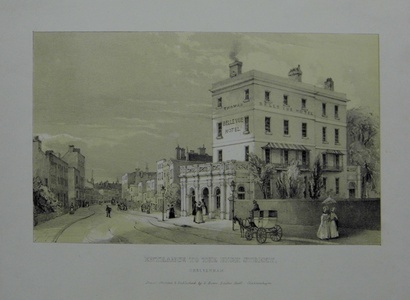| Method | Lithograph with tint stone |
| Artist | George Rowe |
| Published | Drawn, Printed & Published by G. Rowe, Exeter Hall, Cheltenham. c.1840 |
| Dimensions | Image 160 x 275 mm, sheet 283 x 389 mm |
| Notes |
George Rowe (1796 - 1864) was one of the most prolific topographical print makers of his time. Born at Exeter in 1796, and showing his artistic talent from an early age, Rowe earned his living as a drawing master in Hastings. It was there that he produced his first known set of topographical prints, Twenty-six Views of Picturesque Scenery of Hastings and its Vicinity, which were published, as lithographs in 1823. Rowe produced many more views of Sussex and Kent before returning to Exeter in around 1826. At Exeter, he continued his teaching and produced many prints of Devon. In 1832, Rowe, his wife and two young children moved to Cheltenham. Here, Rowe established a Repository of Arts, at which he sold artists' materials and undertook general printing work. He also began to produce prints of the town, which were initially published by a local librarian, although by 1834 Rowe had acquired his own lithographic printing press and was able to publish his own work. In 1845 he published The Illustrated Cheltenham Guide, which included over two-hundred small vignette views. Rowe also spent about seven years in Australia. On his return to England, probably in 1859, he settled at Exeter and began work on a series of panoramic views of the goldfields and Tasmania that were to win him a gold medal at the 1862 London International Exhibition. Condition: Good, some creasing around the corners of the sheet |
| Framing | unmounted |
| Price | £55.00 |
| Stock ID | 31087 |

